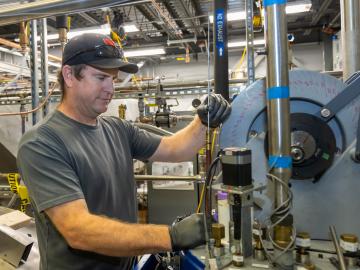Filter News
Area of Research
- Advanced Manufacturing (3)
- Biology and Environment (29)
- Clean Energy (99)
- Computational Biology (1)
- Computational Engineering (2)
- Computer Science (4)
- Electricity and Smart Grid (1)
- Energy Sciences (1)
- Functional Materials for Energy (2)
- Fusion and Fission (12)
- Fusion Energy (8)
- Isotope Development and Production (2)
- Isotopes (6)
- Materials (75)
- Materials for Computing (6)
- Mathematics (1)
- National Security (25)
- Neutron Science (28)
- Nuclear Science and Technology (19)
- Nuclear Systems Modeling, Simulation and Validation (1)
- Quantum information Science (2)
- Supercomputing (62)
News Topics
- (-) Advanced Reactors (34)
- (-) Clean Water (29)
- (-) Cybersecurity (35)
- (-) Energy Storage (108)
- (-) Irradiation (3)
- (-) Physics (60)
- (-) Space Exploration (25)
- (-) Summit (57)
- 3-D Printing/Advanced Manufacturing (116)
- Artificial Intelligence (87)
- Big Data (50)
- Bioenergy (88)
- Biology (96)
- Biomedical (58)
- Biotechnology (21)
- Buildings (55)
- Chemical Sciences (60)
- Climate Change (95)
- Composites (25)
- Computer Science (184)
- Coronavirus (46)
- Critical Materials (25)
- Decarbonization (75)
- Education (4)
- Element Discovery (1)
- Emergency (2)
- Environment (192)
- Exascale Computing (36)
- Fossil Energy (5)
- Frontier (41)
- Fusion (53)
- Grid (61)
- High-Performance Computing (83)
- Hydropower (11)
- Isotopes (49)
- ITER (7)
- Machine Learning (46)
- Materials (141)
- Materials Science (137)
- Mathematics (6)
- Mercury (12)
- Microelectronics (2)
- Microscopy (51)
- Molten Salt (8)
- Nanotechnology (60)
- National Security (59)
- Net Zero (12)
- Neutron Science (130)
- Nuclear Energy (105)
- Partnerships (40)
- Polymers (31)
- Quantum Computing (31)
- Quantum Science (66)
- Renewable Energy (2)
- Security (24)
- Simulation (45)
- Software (1)
- Statistics (3)
- Sustainable Energy (122)
- Transformational Challenge Reactor (7)
- Transportation (94)
Media Contacts

Associate Technician Sean Hollander is the keeper of the Fundamental Neutron Physics Beamline, which is operated by the Physics Division at the Spallation Neutron Source at ORNL, where scientists use neutrons to study all manner of matter.

ORNL scientists develop a sample holder that tumbles powdered photochemical materials within a neutron beamline — exposing more of the material to light for increased photo-activation and better photochemistry data capture.

Researchers set a new benchmark for future experiments making materials in space rather than for space. They discovered that many kinds of glass have similar atomic structure and arrangements and can successfully be made in space. Scientists from nine institutions in government, academia and industry participated in this 5-year study.

Researchers tackling national security challenges at ORNL are upholding an 80-year legacy of leadership in all things nuclear. Today, they’re developing the next generation of technologies that will help reduce global nuclear risk and enable safe, secure, peaceful use of nuclear materials, worldwide.

Researchers at ORNL are developing battery technologies to fight climate change in two ways, by expanding the use of renewable energy and capturing airborne carbon dioxide.

When scientists pushed the world’s fastest supercomputer to its limits, they found those limits stretched beyond even their biggest expectations. In the latest milestone, a team of engineers and scientists used Frontier to simulate a system of nearly half a trillion atoms — the largest system ever modeled and more than 400 times the size of the closest competition.

Scientists at Oak Ridge National Laboratory and six other Department of Energy national laboratories have developed a United States-based perspective for achieving net-zero carbon emissions.
Simulations performed on the Summit supercomputer at ORNL are cutting through that time and expense by helping researchers digitally customize the ideal alloy.

Groundwater withdrawals are expected to peak in about one-third of the world’s basins by 2050, potentially triggering significant trade and agriculture shifts, a new analysis finds.

An international team using neutrons set the first benchmark (one nanosecond) for a polymer-electrolyte and lithium-salt mixture. Findings could produce safer, more powerful lithium batteries.




